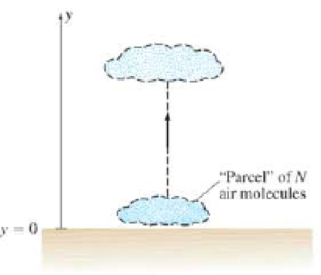
Concept explainers
(III) Consider a parcel of air moving to a different altitude y in the Earth’s atmosphere (Fig. 19–33). As the parcel changes altitude it acquires the pressure P of the surrounding air. From Eq. 13–4 we have
where ρ is the parcel’s altitude-dependent mass density.

FIGURE 19–33 Problem 56.
During this motion, the parcel’s volume will change and, because air is a poor heat conductor, we assume this expansion or contraction will take place adiabatically. (a) Starting with Eq. 19–15, PVγ = constant, show that for an ideal gas undergoing an adiabatic process, P1−γTγ = constant. Then show that the parcel’s pressure and temperature are related by
and thus
(b) Use the
where m is the average mass of an air molecule and k is the Boltzmann constant. (c) Given that air is a diatomic gas with an average molecular mass of 29, show that dT/dy = −9.8 C°/km. This value is called the adiabatic lapse rate for dry air. (d) In California, the prevailing westerly winds descend from one of the highest elevations (the 4000-m Sierra Nevada mountains) to one of the lowest elevations (Death Valley, −100 m) in the continental United States. If a dry wind has a temperature of −5°C at the top of the Sierra Nevada, what is the wind’s temperature after it has descended to Death Valley?
Want to see the full answer?
Check out a sample textbook solution
Chapter 19 Solutions
Modified Mastering Physics With Pearson Etext -- Standalone Access Card -- For Physics For Scientists & Engineers With Modern Physics (5th Edition)
Additional Science Textbook Solutions
College Physics: A Strategic Approach (3rd Edition)
University Physics with Modern Physics (14th Edition)
Conceptual Integrated Science
College Physics
University Physics Volume 1
Tutorials in Introductory Physics
- (II) Water is stored in an artificial lake created by a dam (Fig. 15–27). The water depth is 48 m at the dam, and a steady flow rate of 32 m³/s is maintained through hydro- electric turbines installed near the base of the dam. How much electrical power can be produced? FIGURE 15-27 Problem 55: Flaming Gorge Dam on the Green River in Utah.arrow_forward(II) If the pressure in a gas is tripled while its volume isheld constant, by what factor does vrmschange?arrow_forward64. (II) A pressure cooker is a sealed pot designed to cook food with the steam produced by boiling water somewhat above 100°C. The pressure cooker in Fig. 13-32 uses a weight of mass m to allow steam to escape at a certain pressure through a small hole (diameter d) in the cooker's lid. If d = 3.0 mm, what should m be in order to cook food at 120°C? Assume that Weight (mass m) m atmospheric pressure outside the cooker is 1.01 X 105 Pa. Diameter d FIGURE 13-32 Problem 64. Steam Water Waterarrow_forward
- (II) Show that for a mixture of two gases at the same tem- perature, the ratio of their rms speeds is equal to the inverse ratio of the square roots of their molecular masses, vi/v2 = VM,/M¡ .arrow_forwardA mixture of water (density=1000 kg/m3) and vapor flowing with a mass rate = 7 kg/sec in a pipe of 1000 m long and 50 mm diameter, the gas fraction is 20%,then the volumetric rate of the water is: 1arrow_forward(II) Show that the rms speed of molecules in a gas is given by vrms = V3P/p, where P is the pressure in the gas and pis the gas density.arrow_forward
- (II) A storage tank contains 21.6 kg of nitrogen(N2) at anabsolute pressure of 3.45 atm. What will the pressure be ifthe nitrogen is replaced by an equal mass o CO2 at the sametemperature?arrow_forward(I) What is the approximate mass of air in a living room 5.6 m x 3.6 m × 2.4 m?arrow_forwardConsider a given volume of helium gas at room temperature (20.0 °C). [Molar mass of helium is 4.00 × 10-³ kg mol−1] (i) Calculate the average speed of a molecule of the gas. Give your answer in scientific notation and specified to an appropriate number of significant figures, in the empty box below. = m s−1 (ii) At what temperature would the average translational energy of the gas be one third of the average translational energy at room temperature? Give your answer by entering numbers, specified to an appropriate number of significant figures, into the empty box below. temperature = Karrow_forward
- The atmospheric pressure on earth is 101kPa. The surface area of the earth is related to its mean radius r which has a value of 6400km. Calculate the mass of the earth’s atmosphere, assuming g does not vary with height above the Earth’s surface. Calculate the number of nitrogen and oxygen molecules present on this atmosphere (take note: molecules).arrow_forward-) Suppose 4 L of gas is undergoing a pressure change from 2 atm to 8 atm. What will be the new volume of the gas?arrow_forward(II) Is a gas mostly empty space? Check by assuming that the spatial extent of the gas molecules in air is about lo = 0.3 nm so one gas molecule occupies an approximate volume equal to l . Assume STP.arrow_forward

 Principles of Physics: A Calculus-Based TextPhysicsISBN:9781133104261Author:Raymond A. Serway, John W. JewettPublisher:Cengage Learning
Principles of Physics: A Calculus-Based TextPhysicsISBN:9781133104261Author:Raymond A. Serway, John W. JewettPublisher:Cengage Learning

